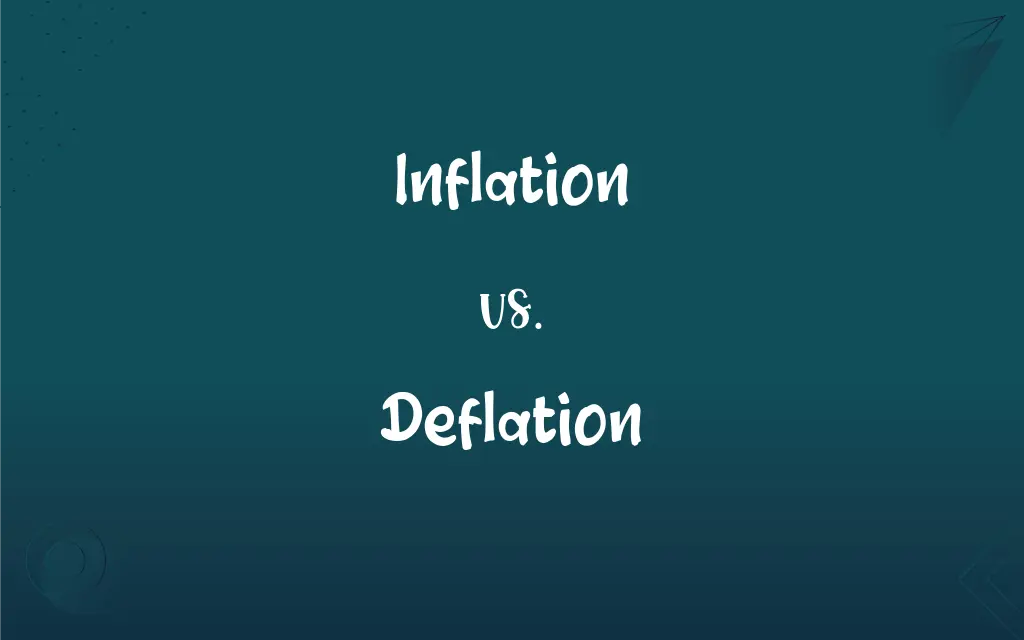Inflation vs. Deflation: What's the Difference?
By Janet White || Published on November 22, 2023
Inflation is the increase in prices and decline in purchasing power over time, while deflation is the decrease in prices and increase in the value of money.

Key Differences
Inflation is characterized by rising prices and reduced purchasing power, often driven by an increase in money supply or demand outpacing supply. Deflation, in contrast, is marked by falling prices and increased purchasing power, typically resulting from a reduction in the supply of money or credit.
Inflation can erode the value of money, making it less valuable over time, and is often linked to a growing economy. Deflation, however, increases the value of money but can lead to decreased economic activity, as consumers may delay purchases.
Central banks often combat inflation through monetary policies like raising interest rates, aiming to stabilize prices. To counteract deflation, central banks might lower interest rates and inject money into the economy to stimulate spending.
Inflation can benefit debtors by allowing them to repay loans with less valuable money, while creditors are disadvantaged. In deflationary scenarios, the opposite occurs: debtors find it harder to repay debts, and creditors gain as the value of repayments increases.
Sustained inflation can lead to hyperinflation, severely disrupting economies, while prolonged deflation can cause economic depression, leading to high unemployment and business failures.
ADVERTISEMENT
Comparison Chart
Price Trend
Prices increase
Prices decrease
Purchasing Power
Decreases
Increases
Economic Activity
Often associated with economic growth
May lead to reduced economic activity
Monetary Policy
Managed through higher interest rates, reduced money supply
Addressed with lower interest rates, increased money supply
Impact on Debt
Beneficial for debtors, harmful for creditors
Harmful for debtors, beneficial for creditors
ADVERTISEMENT
Long-term Risks
Can lead to hyperinflation
Can lead to economic depression
Consumer Behavior
Encourages immediate spending
Promotes delayed spending
Investment Value
Erodes the real value of investments
Increases the real value of investments
Business Profits
Can boost nominal profits
Can reduce nominal profits
Inflation and Deflation Definitions
Inflation
It can be caused by an increase in money supply or demand for products.
The government's stimulus package led to inflation by increasing money in circulation.
Deflation
During deflation, electronics became cheaper than the previous year.
Deflation can lead to a decrease in business revenues and economic stagnation.
Inflation
It represents a decrease in the purchasing power of a currency.
Inflation made the dollar less powerful, reducing what consumers could buy with it.
Deflation
Deflation is the decrease in the general price level of goods and services.
Businesses suffered as deflation led to lower prices and revenues.
Inflation
Inflation is often measured by the Consumer Price Index (CPI).
The CPI report indicated a 3% inflation rate this year.
Deflation
It indicates an increase in the value of a currency.
To combat deflation, the central bank cut interest rates to encourage spending.
Inflation
Inflation is the rate at which the general level of prices for goods and services rises.
During inflation, a loaf of bread costs more than it did last year.
Deflation
With deflation, consumers found their dollars buying more than before.
It's often addressed by central banks lowering interest rates.
Inflation
Inflation can erode savings and fixed incomes.
Seniors on fixed incomes struggle as inflation diminishes their purchasing power.
Deflation
Deflation can be a sign of economic downturns.
The deflation was a result of decreased consumer spending during the recession.
Inflation
The act of inflating or the state of being inflated.
Deflation
The act of deflating or the condition of being deflated.
Inflation
A persistent increase in the level of consumer prices or a persistent decline in the purchasing power of money.
Deflation
A persistent decrease in the level of consumer prices or a persistent increase in the purchasing power of money.
Inflation
The rate at which this increase occurs, expressed as a percentage over a period of time, usually a year.
Deflation
The lifting and removal of small, loose particles, especially silt and clay particles, by eddies of wind.
FAQs
What causes inflation?
Inflation is caused by factors like increased money supply and higher demand than supply.
How does deflation affect consumers?
Deflation increases consumers' purchasing power, but may also lead to economic slowdown.
Can inflation be beneficial?
Moderate inflation can stimulate spending and economic growth.
How does inflation affect consumers?
Inflation reduces consumers' purchasing power, making goods and services more expensive.
Is deflation always bad?
While deflation can increase purchasing power, it often signals economic problems.
What is the Consumer Price Index (CPI)?
The CPI is a measure that examines the weighted average of prices of consumer goods and services.
What causes deflation?
Deflation is often caused by a decrease in money supply or demand for goods and services.
Does inflation affect all sectors equally?
No, inflation impacts sectors differently based on factors like demand and cost structures.
How do governments control inflation?
Governments control inflation through monetary policies like adjusting interest rates and money supply.
Are savings safe during deflation?
Savings can retain or increase their value during deflation, but economic downturns may pose risks.
How does inflation impact interest rates?
Central banks often raise interest rates to control inflation.
Can inflation affect currency value?
Yes, inflation can decrease the value of currency in international markets.
How does inflation affect debt?
Inflation benefits debtors, as they repay debts with less valuable money.
How can deflation be reversed?
Deflation can be reversed by measures like lowering interest rates and injecting money into the economy.
What is hyperinflation?
Hyperinflation is extremely high and typically accelerating inflation.
What is cost-push inflation?
Cost-push inflation happens when the costs of production increase, leading to higher prices.
What happens to loans during deflation?
During deflation, the real value of loan repayments increases, affecting debtors negatively.
What role do central banks play in deflation?
Central banks try to counter deflation by monetary easing like lowering interest rates.
What is wage deflation?
Wage deflation refers to a decrease in nominal wages across the economy.
What is demand-pull inflation?
Demand-pull inflation occurs when demand for goods and services exceeds their supply.
About Author
Written by
Janet WhiteJanet White has been an esteemed writer and blogger for Difference Wiki. Holding a Master's degree in Science and Medical Journalism from the prestigious Boston University, she has consistently demonstrated her expertise and passion for her field. When she's not immersed in her work, Janet relishes her time exercising, delving into a good book, and cherishing moments with friends and family.
































































